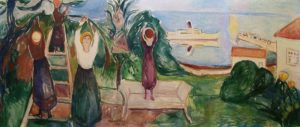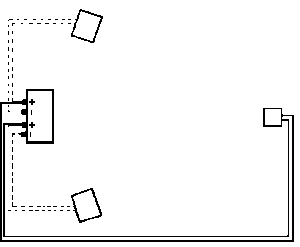A very small one.
„Elements which can be eliminated have been eliminated” is how Abbas Kiarostami once described his late turn toward minimalism. While he was known for the intricate, metatextual playfulness of his work, he also spent much of his career trying to achieve a certain purity of expression, one that he at first found more readily in his photographs and his poetry. “I want my films to become closer to my photography and more distant from storytelling,” he said in a 2000 interview, and the ensuing decade and a half would prove pivotal in that effort.“ So beginnt ein kleiner Text über das letzte Werk des iranischen Regisseurs, und soviel zur kleinen Vorrede. Es ist wieder mal an der Zeit, Brian ein kleines Päckchen zu schicken. Das Spiel spiele ich gelegentlich, seit 1989, und es begann wohl mit David Darlings „Cello“ (von einigen Manafonisten gerade mit Sternen hochdekoriert), nein, es begann mit Eleni Karandrous „Music For Films“, das Manfred E. titeltechnisch als kleine Referenz an Brians „Music for Films“ wählte, obwohl die Musik der Griechin durchweg real existierenden Filmen zugedacht war. Durchschlagende Resonanz fanden in den Folgejahren, in seinen Gehörgängen, Heiner Goebbels‘ „Landscape with Argonauts“ und das Album der Books mit dem grünen Cover, „Lost and Safe“, letzteres hat er eine Zeitlang nahezu obsessiv gehört. Das letzte Päckchen ist schon einige Jahre her – in meinem Interview mit Brian und Karl Hyde stellte sich heraus, dass „Colossal Youth“ von den Young Marble Giants völlig an ihm vorüber gegangen war (die Platte erschien in seinen New Yorker Jahren, da sind Cardiff und der Plattenladen von Rough Trade in Notting Hill weit weg) – ein Klassiker, dem einst ein gewisser D.D. Diederichsen eine besondere Nachbarschaft attestierte, und zwar die von Eno und Schubert, bei letzterem meine ich Franz. Nebenbei, in den nächsten Klanghorizonten wird tatsächlich einmal Franz zu hören sein, Brian auch, aus einer Kirche übrigens, „Union Chapel“ in Islington, berühmt für ihre besondere Akustik. Wie gesagt, ein selten betriebenes Spiel, aber jetzt ist es wieder mal an der Zeit, dachte ich, als ich „Chalk Hill Blue“ von Will Burns und Hannah Peel hörte, „poetry & music“, eine fantastische CD (s. a. „Albums of April“), gewiss ein Top Ten-Album meiner Jahresbestenliste – Brian besass ja stets ein Faible für „spoken word-music“ (das hört man bereits auf seinem ersten Songalbum, wenn „Dead Finks Don‘t Talk“ erklingt), hatte dann ja auch mal mit Rick Holland einen Lyriker zum Duopartner gemacht. Und als ich vor Wochen tief in Trance versank, als ich den letzten Film von Abbas Kiarostami erlebte, „24 Frames“, einen Film ohne Handlung, ein „ambient movie“, hintergründig, abgründig, und ein Ende, bei dem nur tote Augen trocken bleiben, war der Gedanke naheliegend, Brian möge sich einmal diesen Trip gönnen, auf einer grossen Leinwand – und mit gutem Surroundssystem, was für ihn kein Problem darstellen dürfte. Zudem ist diese Edition von Criterion (s. Blogroll) mit spannenden Extras ausgestattet. Selten genug, dass eins meiner Päckchen nach London mit drei Neuerscheinungen aufwartet, aber diesmal ist es so gekommen. Das dritte Teil stammt wieder mal aus dem Hause ECM, und ich habe einen Narren gefressen an dem in der zweiten Aprilhälfte erscheinenden Werk der aus Armenien stammenden und in Los Angeles lebenden Sängerin und Pianistin Areni Agbabian – an ihrer Seite der Schlagwerker Nikolaus Stocker (man kennt ihn von Nik Bärtsch, hier agiert er fernab aller Module), und der Produzent Manfred Eicher, der eine sehr kurze, gute dreissig Sekunden währende Komposition namens „Whiteness“ beisteuert (wie das wohl zustande gekommen ist?) – vielleicht hat er im Studio in Zürich eine Melodie gesummt, und Areni hat sie sofort gespielt. Ich muss noch herausfinden, was mich an „Bloom“ so besonders fesselt (und ich rede hier von Arenis „Bloom“, nicht von Brians „Bloom“), rasch auf den Punkt bringen kann ich es nicht, die üblichen Floskeln machen wenig Sinnlichkeit. Jedenfalls freut sie sich darauf, meine Fragen, die auch noch gefunden werden wollen, auf ihrem Smartphone zu beantworten. So, das Päckchen ist geschnürt. Gleich geht es, mit einer Briefmarke von einem Observatorium der Sterne, auf die Reise ins alte England, das seit Jahr und Tag dabei ist, von Debakel zu Debakel zu stolpern. Die Konferenz der Idioten tagt fast täglich. Ich sehe Theresa noch vor mir, wie sie in Brüssel zu einem ABBA-Song auftritt, und es wirkt so verklemmt, als wäre sie auf dem Weg zum Chiropraktiker, und hätte noch nie von Elvis‘ Hüftschwung gehört. Well, let‘s put „Eton Alive“ on the record player, Sleaford Mods‘ healing music of a different, a very different kind.
„So Much Longing in So Little Space“. That‘s not the title of the painting, it’s the title of the book from Norway’s epic self-analyst Karl Ove Knausgård who actually paints a refreshingly ego-free portrait of Edvard Munch, my favourite painter, along with Claude Monet. Look at this text, a marketplace of music, pictures, frames, and you‘re just about to finish it – anyway you find something to cherish, to be blown away by, and, maybe, you’ll read it one more time, slower, a bit slower, whatever you like, of course, but be sure about one thing, and this is guaranteed: elements that can be eliminated have not been eliminated.
The smoke of the campfires, into which you are throwing everything superfluous, make your eyes smart.

